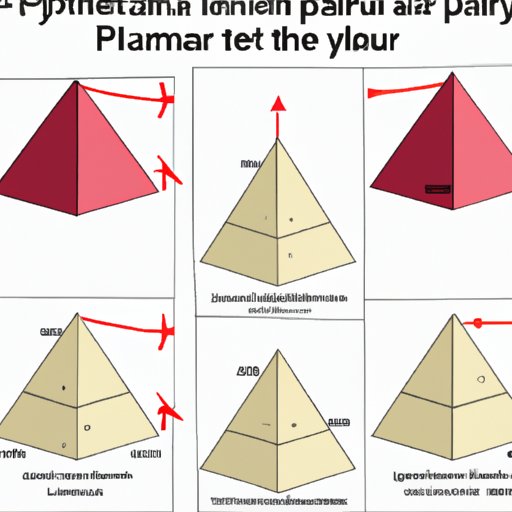
Introduction
When we think of pyramids, the first thing that comes to mind might be the ancient wonders of the world or images of Egypt. But did you know that pyramids are more than just historical landmarks? They also have practical applications in fields such as architecture and engineering. Calculating the volume of a pyramid is an important skill for anyone interested in these fields. In this article, we will explore the step-by-step process of finding the volume of a pyramid and provide some practical applications for this concept.
Step-by-Step Guide to Finding the Volume of a Pyramid: A Beginner’s Tutorial
Before we dive into the formula for calculating pyramid volume, it’s important to understand what volume means. In geometry, volume is the measure of space occupied by an object. In other words, it’s the amount of space inside a three-dimensional object.
The formula for finding the volume of a pyramid is:
Volume = (1/3) x base area x height
To use this formula, follow these steps:
- Measure the length and width of the base of the pyramid
- Multiply the length and width to find the base area
- Measure the height of the pyramid from the base to the vertex (top point)
- Plug the base area and height into the formula and solve for volume
Let’s take a look at an example to see how this works:
Suppose we have a pyramid with a rectangular base that measures 4 meters by 6 meters. The height of the pyramid is 8 meters. To find the volume, we would use the following formula:
Volume = (1/3) x 4m x 6m x 8m = 64 cubic meters
Therefore, the volume of the pyramid is 64 cubic meters.
You can use this formula for any type of pyramid, whether it has a square, rectangular, or even a triangular base.
Mastering Geometry: Unlocking the Secrets to Calculating Pyramid Volume
If you’re interested in mastering geometry and understanding more about pyramid volume, it’s helpful to know that there are different types of pyramids. The most common types are:
- Square pyramid
- Triangular pyramid
- Rectangular pyramid
The formula for finding the volume of a square pyramid is:
Volume = (1/3) x base area x height
The formula for finding the volume of a triangular pyramid is:
Volume = (1/3) x base area x height
where the base area is calculated using the formula:
Base area = (1/2) x base x height of the triangle
The formula for finding the volume of a rectangular pyramid is:
Volume = (1/3) x base area x height
where the base area is calculated by multiplying the length and width of the base together.
It’s important to note that some pyramids may have different formulas for calculating volume based on their shape. Be sure to consult with your teacher or reference materials for specific formulas for unusual pyramid shapes.
Formulas and Examples: The Ultimate Resource for Solving Pyramid Volume Problems
Here are some additional formulas for finding the volume of pyramids:
Volume of a regular hexagonal pyramid = (1/3) x (3√3/2 x s^2) x height
Volume of a regular octagonal pyramid = (1/3) x (2 + 4√2) x s^2 x height
Volume of a right circular pyramid = (1/3) x π x r^2 x height
Let’s take a look at an example using one of these formulas:
Suppose we have a regular hexagonal pyramid with a side length (s) of 6 meters and a height of 9 meters. To find the volume, we would use the following formula:
Volume = (1/3) x (3√3/2 x s^2) x height
Volume = (1/3) x (3√3/2 x 6m^2) x 9m = 54√3 cubic meters
Therefore, the volume of the regular hexagonal pyramid is 54√3 cubic meters.
It’s important to practice using these formulas to solve problems, as they will likely be a part of geometry curriculum in later semesters.
Beyond Math Class: Practical Applications and Importance of Understanding Pyramid Volume
Although calculating the volume of a pyramid may seem like a purely mathematical skill, it has many practical applications in real life. For example:
- By understanding how to calculate pyramid volume, architects can estimate the amount of materials needed for building a pyramid-shaped structure.
- Engineers may use this concept to design buildings with pyramid features.
- Physicists use the basics of pyramid volume calculation in determining the weight and mass of pyramids.
Understanding this concept not only helps in practical settings but can also open doors leading towards higher learning.
Challenging Pyramid Volume Problems and How to Solve Them: Tips and Tricks from Experts
Once you’re comfortable with the basic concepts of pyramid volume, you may want to challenge yourself with more complex problems. Here are a few tips from experts to help you solve these problems:
- Remember to measure all dimensions accurately, as even a small mistake can have a significant effect on the final answer.
- When dealing with irregular pyramids, try to break down the pyramid into simpler shapes and calculate their volumes separately.
- When dealing with large numbers, use scientific notation or a calculator to help avoid errors.
Conclusion
Calculating the volume of a pyramid is a fundamental skill in geometry that has practical applications across various industries. In this article, we’ve covered the basic formula for finding pyramid volume and provided step-by-step instructions along with some visual aids. By mastering this concept, you can unlock the secrets to geometry and open doors towards higher learning in the future.




